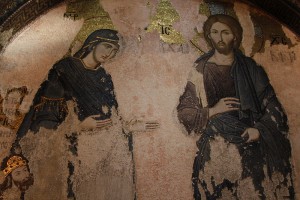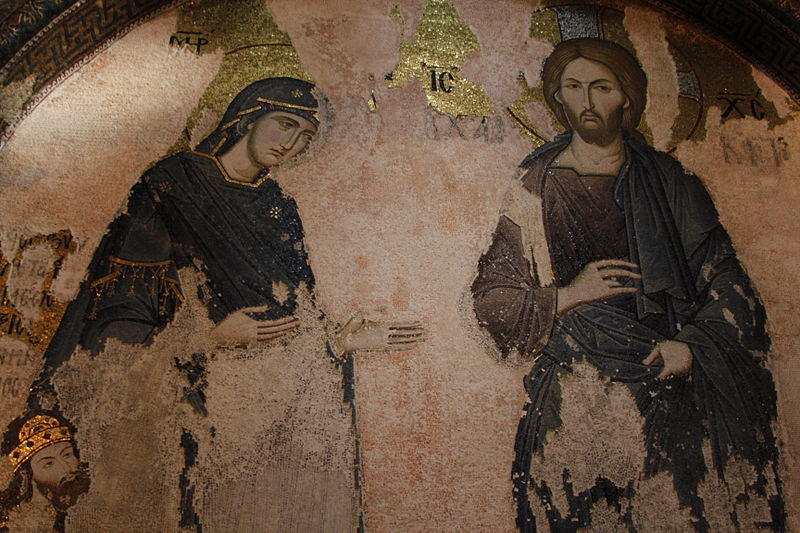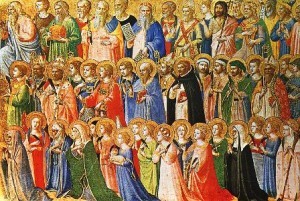
I recently had an interaction with a commenter on this blog who brought up the common Protestant objection that, since there is one (sole) mediator between God and Man, Jesus, asking the saints to pray for us is useless, wrong and maybe even sinful. Yes it is quite a common objection, more so today that I remember twenty or thirty years ago.
Thus, to the suggestion by another comment that one might ask help from Our Lady, the commenter, (Gerry), objected as such:
JESUS IS THE MEDIATOR , Counselor, Helper, Intercessor, Advocate, and Comforter. MARY IS THE SYMBOL OF THE CHURCH.
- 1 Timothy 2:5 For there is one God, and there is ONE MEDIATOR between God and men, the man Christ Jesus, who gave himself as a ransom for all.
- Hebrews 12:24 to JESUS THE MEDIATOR of a new covenant, and to the sprinkled blood that speaks a better word than the blood of Abel.
- Hebrews 9:15 For this reason CHRIST IS THE MEDIATOR of a new covenant, that those who are called may receive the promised eternal inheritance—now that he has died as a ransom to set them free from the sins committed under the first covenant.
- 1 John 2:1 My little children, I write these things to you so that you may not sin. If anyone sins, we have a Counselor [Greek Parakleton: Counselor, Helper, Intercessor, Advocate, and Comforter.] with the Father, Jesus Christ, the righteous.
- John 14:16-17 I will pray to the Father, and he will give you another Counselor, [Greek Parakleton: Counselor, Helper, Intercessor, Advocate, and Comforter.] that he may be with you forever,- the Spirit of truth, whom the world can’t receive; for it doesn’t see him, neither knows him. You know him, for he lives with you, and will be in you.
- John 14:26 But the Counselor, the Holy Spirit, whom the Father will send in my name, he will teach you all things, and will remind you of all that I said to you.
- John 15:26 When the Counselor [Greek Parakletos: Counselor, Helper, Advocate, Intercessor, and Comforter.] has come, whom I will send to you from the Father, the Spirit of truth, who proceeds from the Father, he will testify about me.
- John 16:13 However when he, the Spirit of truth, has come, he will guide you into all truth, for he will not speak from himself; but whatever he hears, he will speak. He will declare to you things that are coming.
- Romans 8:26 Likewise the Spirit also helps in our weaknesses. For we do not know what we should pray for as we ought, but the Spirit Himself makes intercession for us[a] with groanings which cannot be uttered. Now He who searches the hearts knows what the mind of the Spirit is, because He makes intercession for the saints according to the will of God.
Learn to live from Mary! She asked you to obey and listen to her son Jesus! Focus on Jesus, not Mary
My own response to Gerry was as such:
Well, we do not speak of or teach a substitutional mediation in invoking the saints, as if we were trying to go to the Father apart from Jesus’ Mediation.
Rather we speak of a subordinate mediation when we seek the prayers of the saints, or of one another. For indeed we could have no communion with them or each other if it be not for Jesus Christ, who as the head of the Body the Church, unites all his members and facilitates our communion with each other.
You seem to speak of there being one mediator in an absolute sense, excluding any other possible interaction or any subordinate mediation. But Consider, that if there is only one mediator in the absolute sense you say, then you ought never again to ask ANYONE to pray for you. Neither should you attend any church, read any book, listen to any sermon or even read the Bible (since the Bible mediates Jesus words to you).
Now, a “mediator” is someone or something that acts as a kind of go-between, as something which acts to facilitate our relationship with Jesus. And though Jesus mediates our relationship to the Father, he also asked Apostles, preachers and teachers to mediate, to facilitate his relationship with us.
Thus Jesus sent apostles out to draw others to him. And St. Paul says, How, then, can they call on the one they have not believed in? And how can they believe in the one of whom they have not heard? And how can they hear without someone preaching to them? And how can anyone preach unless they are sent? As it is written: “How beautiful are the feet of those who bring good news!” Consequently, faith comes from hearing the message, and the message is heard through the word about Christ. (Rom 10:14-15, 17) And thus Jesus has his relationship with us mediated through his Word, and through the apostles and others who announce that Word and draw us to him.
But since you say there is absolutely only ONE mediator, and no subordinate or deputed mediators, there is therefore no need to ask ANYONE or ANYTHING to mediate. So burn your Bible, stop asking anyone to pray for you, seek no advice, NO ONE can mediate a single thing to you Gerry. No one can do this because there is, as you say in an unqualified sense, absolutely only ONE mediator. ONE!
Further, it also seems to follow you must also cease and desist from trying mediate anything. For if no one can mediate anything of Jesus to you, than neither can you mediate anything to them, since as you say there is absolutely only ONE mediator. No you cannot speak Jesus’ words or his will to others, because you are trying to mediate, you are acting as a kind of go-between, as someone who speaks God’s will to another. But Gerry, according to you there is only ONE mediator! Thus, How dare you try and get between Jesus and anyone else, there is ONE, absolutely only ONE mediator. Jesus doesn’t need you and you are violating the ONE mediator rule.
But as for me, I will go one praying for you and others because I see that there is a subordinated mediatorship in service of Christ’s supreme mediatorship. And just like the Bible can mediate his presence and will, or like a preacher can mediate his word, so too the prayers of others, including the Saints, can also convey my prayers to Him, and Jesus can mediate my prayers to the Father.
Consider the analogy of the Body, since the Church is Christ’s body. Jesus has one body and all the parts are connected through the Head, who is Jesus. Consider your own body. All the members of your body have communion and unity through your head, your mind. There are different ways to have interaction with others. Perhaps some one will reach you through your ears, by speaking, or by taping you on your shoulder, or visually by waving. And thus, various members of your body facilitate (mediate) interaction with others in different ways, but it is all facilitated through the head of your body, your mind. So too do I confidently expect to reach Jesus in different ways, whether directly, or through one of his members, realizing that He himself facilitates it.
Regarding your thoughts on Mary: Since Jesus’ body is the Church, this makes Mary Mother of the Church, not just a symbol of it, as you call her. Since she is the Mother of Jesus and he is the head of the Body, the Church. It would be freakish to consider a mother giving birth to only the head of her child, but not the rest of his Body. So Mary is Mother of the Church. If she gave birth to the Head, she gave birth to the Body. Therefore Mary is Mother of the Church, which is the Body of Christ.
Further your instruction to follow Mary’s instruction to obey Jesus is a reference to her final recorded words: “Do whatever he tells you.” (Jn 2:5). I am not sure if you recall the context of this verse, but in saying this she had been interceding with Jesus on behalf of a couple at wedding where the wine ran short! She was acting as a mediator by communicating to Jesus their needs! And, When Jesus resists her request to make wine at first, she uses her motherly charm to overcome his resistance to such an extent that he is making gallons of wine!
Isn’t it ironic that you would pick a verse from Scripture to dismiss intercessory prayer which is actually a powerful example of that very practice?
But as for you Gerry, the consequence of your interpretation of absolutely and only ONE mediator, is that you must say nothing, hear nothing, interact with no one, depend on no one, and live in a closed “me and Jesus” circle. You must shut absolutely everyone and everything else out, including the Bible, for there is ONE MEDIATOR – no one, and nothing can mediate Jesus to you. There can be no go-betweens.
Well of course my answer to Gerry can use some improvements. You will add them. Also Catholic Answers has many wonderful resources. But the point here is that the Catholic practice of asking prayers of saints is attested not only Scripture, but also by common sense and the long practice of the faith.



